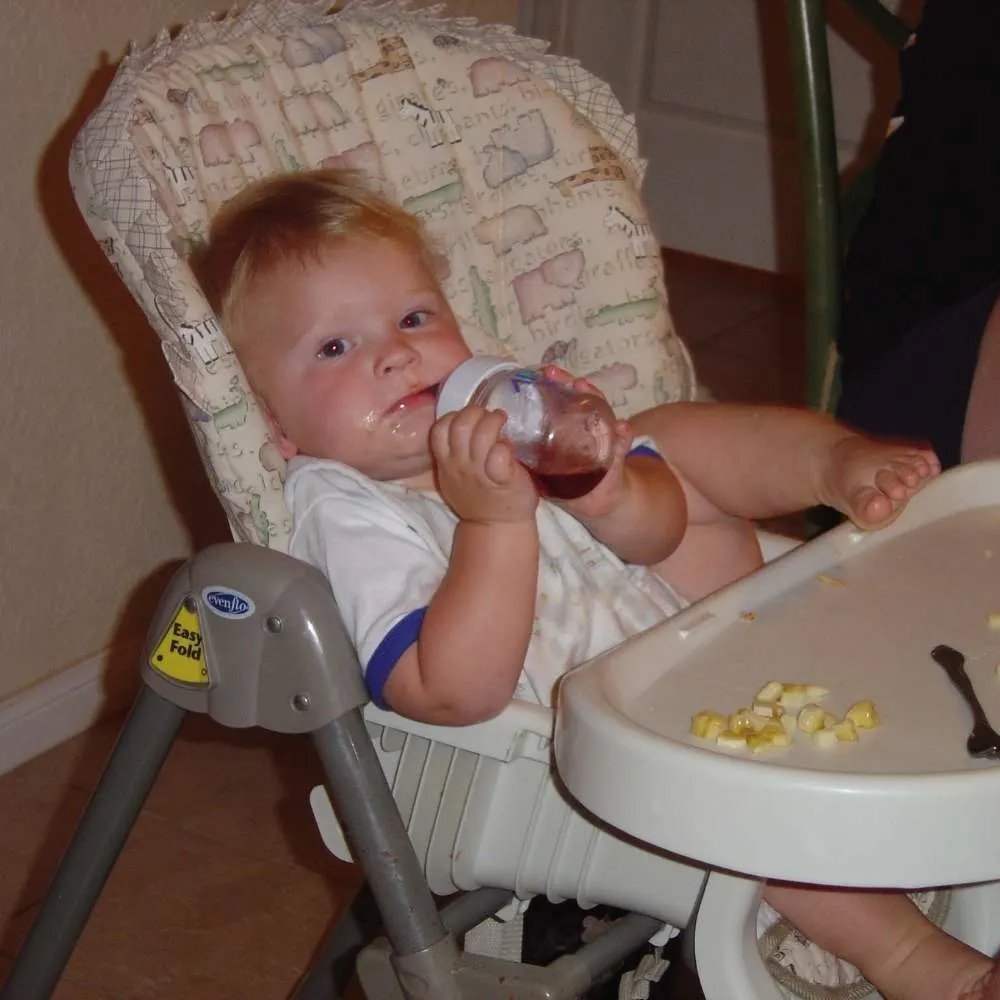- Clay Moon Phase Wall Hanging - July 4, 2023
- What To Do When a Toddler Won’t Keep Their Blanket On - June 10, 2023
- How Do Child Locks Work in Cars? (And When To Use Them!) - June 10, 2023
It’s common for toddlers to get upset when put in a high chair. My son used to throw a fit every time! Sometimes the problem is that the high chair is uncomfortable, while other times, it’s simply a matter of not wanting to be restricted or treated like a baby anymore. So, how do you get your toddler to eat in a high chair?
To get your toddler to eat in a high chair, make mealtime a routine fun social event by sitting with them and making them feel like a grown-up. Give them their own utensils. You may also remove the tray from their high chair and push the chair up to the table like a big kid or use a booster seat.
There are several ways to get a toddler to sit in a high chair, and your strategy should be based on your child’s particular personality and developmental needs. The rest of this article will cover the different things you can try to get your toddler to eat in a high chair, so keep reading!

1. Understand Your Toddler
Once you have established that the high chair you got for your toddler is safe and comfortable, you should ask yourself how well you know your child and how good you are at reading their verbal and non-verbal cues. Some of the things you should focus on are:
- What makes them happy?
- What makes them nervous or angry?
- What seems to soothe them?
- Under what circumstances do they get most restless?
- How do they respond to different stimuli?
By getting to know your toddler, you’ll be able to identify the most effective strategy to get them to eat in a high chair. Remember that not all toddlers are alike and that your child’s age plays a crucial role in shaping their developmental needs.
Because one-year-olds are yet to develop a strong sense of independence, it’s far easier to get them to sit in their highchairs than older children.
The older your child gets, the more reluctant they’ll be to do things that they associate with being a baby, and that’s because they want you to acknowledge and respect their independence.
The strategy you use to get your child to eat in a high chair will inevitably depend on their age and stage of development.
Generally, toddlers don’t like being put in a corner while everybody else is enjoying their meal. Because children like to imitate those around them, preventing them from doing so is bound to trigger a negative reaction.
If you wish to learn more about the relationship between imitation and children’s behavior, I strongly suggest that you look into Albert Bandura’s social learning theory (source).
According to Bandura, observational learning is crucial in shaping human behavior. From birth, we observe the people around us, encoding and reproducing their behavior.
When the “models” in their lives perceive their behavior as positive, they use positive reinforcement to encourage it. By contrast, when their behavior is considered unacceptable, their models will try to discourage it through negative reinforcement. These two essential processes are what ultimately shape our behavior.
You must remember that your child constantly observes and learns from you, even at the table. As your child grows, they’ll reach a point where they’ll want to imitate the way you sit and eat at the table, hence their reluctance to sit in a high chair.
If you’re not sure whether this is your case, fear not, as there are several signs that you can look out for:
- Your child puts up a fight whenever you put them in their high chair.
- Your child refuses to eat their food out of frustration.
- Your child only calms down when you get them out of their high chair.
Therefore, if you notice any of these signs, chances are your child has reached that stage where they no longer want to be treated as a baby. Perhaps the high chair makes them feel different or distant from the rest of the family, or they perceive the high chair as a threat to their independence. If this is the case, it may be time to transition to a booster seat.
See What To Do When a Toddler Doesn’t Respond to “No”
2. Make Mealtime Fun
If your toddler refuses to eat in a high chair, it could be because they don’t find mealtime particularly exciting: after all, why would anyone want to sit down when there are so many other things to do?
So, if you have a particularly active and vivacious toddler, this may be your case. The good news is that there’s an easy way to get your child to eat in a high chair – make the eating experience more fun.
Turn Eating Into a Fun Experience
All you have to do is turn eating into a fun and multisensorial experience. You can do this by getting them a fun cup to drink from and/or by using brightly colored dishes and utensils. The idea is to make mealtime less dull by providing them with extra-sensory inputs (source).

Sensory activities are an excellent way to change how children perceive food, turning mealtime into a positive experience. Sensory activities are particularly effective when dealing with picky eaters, as they’ve been found to help children become more tolerant of new foods.
Don’t Pressure Your Toddler To Eat
Sometimes, the only reason why toddlers refuse to sit in their highchairs is that they find the idea of sitting down to consume a meal extremely frustrating. More often than not, the cause of their frustration is pressure.
It’s not unusual for toddlers to dislike new flavors and textures, which can add to their frustration at mealtimes. This is when sensory activities come into play.
If you think letting your child play with food is a terrible idea, think again! By incorporating different foods into playtime, your toddler will slowly become more tolerant of new tastes, smells, and textures. Here are a few activities that you can do with your toddler to make them more comfortable around food – and, therefore, more likely to behave during mealtime:
- Paint with liquid or semi-liquid foods such as yogurt and jam.
- Make pasta necklaces and bracelets.
- Involve your toddler in meal prep (be sure to interact and supervise your toddler throughout the process).
If your toddler still doesn’t want to sit in their highchair after incorporating fun activities into mealtime, it may be because they crave more independence (as discussed above) or they feel excluded from everyone else. I’ll get more into this in the next section.
3. Ensure Your Toddler Feels Included at the Table
Like adults, children have an innate need (and desire) to belong. Once you understand this, many of your child’s behaviors won’t seem so strange anymore.
As your child grows, it’s perfectly normal for their needs and expectations to evolve: while an infant doesn’t care to be treated like a special member of the family, a toddler will want you to treat them like you treat everybody else at home.
One thing that toddlers tend to loathe is the idea of being seen as babies, as that tells them that you can’t see their remarkable progress. So, if you treat them in such a way that makes them feel different or excluded from the rest of the family, you may undermine their self-esteem, which is never a good thing.
At this point, you’re probably asking yourself, “What does belonging have to do with eating in a high chair?” You can use your child’s desire to belong to get them to eat in a high chair!
Despite their young age, toddlers are excellent observers: they’re constantly watching what you do and how you do it, what you eat, what you drink, where you sit, and how you interact with them.
Your toddler can clearly see that everybody else in the family sits in proper adult chairs and is constantly given food that’s different from theirs. Now, how do you think that makes them feel?
Giving your toddler food at the same time as everyone else and allowing them to eat some of the food everyone else is eating, are two excellent ways to ensure your toddler feels included at mealtime. Therefore, they’ll be more likely to sit in their highchair. I’ll discuss this more in-depth below.
Feed Your Toddler at the Same Time As Everyone Else
If, for convenience’s sake, you consistently feed your toddler before enjoying your meals with the rest of the family, they’ll most certainly feel excluded, which may cause them to get nervous and upset around mealtime.
Perhaps your toddler doesn’t like being fed by you and would rather eat like everybody else. In other words, they may have reached a stage in their life where they no longer want to be treated like a little baby.
If you want your toddler to be comfortable eating in a high chair, ensure they feel part of the family. Whenever you eat, they should eat too. And whatever you eat, they should at least have a little bit of it – if it’s safe for them to eat it, of course!
The basic idea is that if you eat with your child, they will be more likely to sit still in their high chair and finish their food.
Give Your Toddler Some of Your Food
If your toddler sees you and other family members eat solid food while all they get is mashed food, they may feel like you’re treating them differently from everybody else.
To make them feel included, give them a little bit of solid food and allow them to eat it with their own spoon and fork. This trick alone may make your toddler feel like a respected grown-up.
4. Remove the Tray From the High Chair
As previously mentioned, a good way to get your toddler to eat in a high chair is to acknowledge and respect their growing need for autonomy. Perhaps your toddler doesn’t like their high chair because it restricts their movements or makes them feel like a baby.
If this is the case, there’s a simple way to make your toddler feel like a grown-up without switching to a booster seat. If your high chair comes with a removable tray – as many do these days – remove the tray and bring the high chair closer to the table.
Make sure to give your toddler their own fork and spoon and see how they respond. If they look calm and satisfied, their strong sense of independence is the only thing preventing them from enjoying their meals in their high chair.
If this strategy doesn’t work, it may be time to consider switching to a booster seat. Some booster seats have straps to prevent children from falling off their chairs.
However, strapping your toddler may remind them of the unpleasant feeling they experienced when sitting in their high chair. To see if a booster seat is all your toddler needs for a pleasant dining experience, try a strap-free model and put their chair next to yours for added safety.
Conclusion
Toddlers are little humans that crave independence and inclusion; make sure both of these needs are addressed during mealtime to ensure healthy growth and development!
Author Notes:
Teresa is a Registered Nurse in the State of Texas and the mother of two. Opinions and insights on childcare are based on professional knowledge, academic research, and personal experience.
Recommended Reading:
Make Your Own Beautiful Living Succulent Wreath Centerpiece! Complete video course by Jeannine Romero now available through Skillshare.
